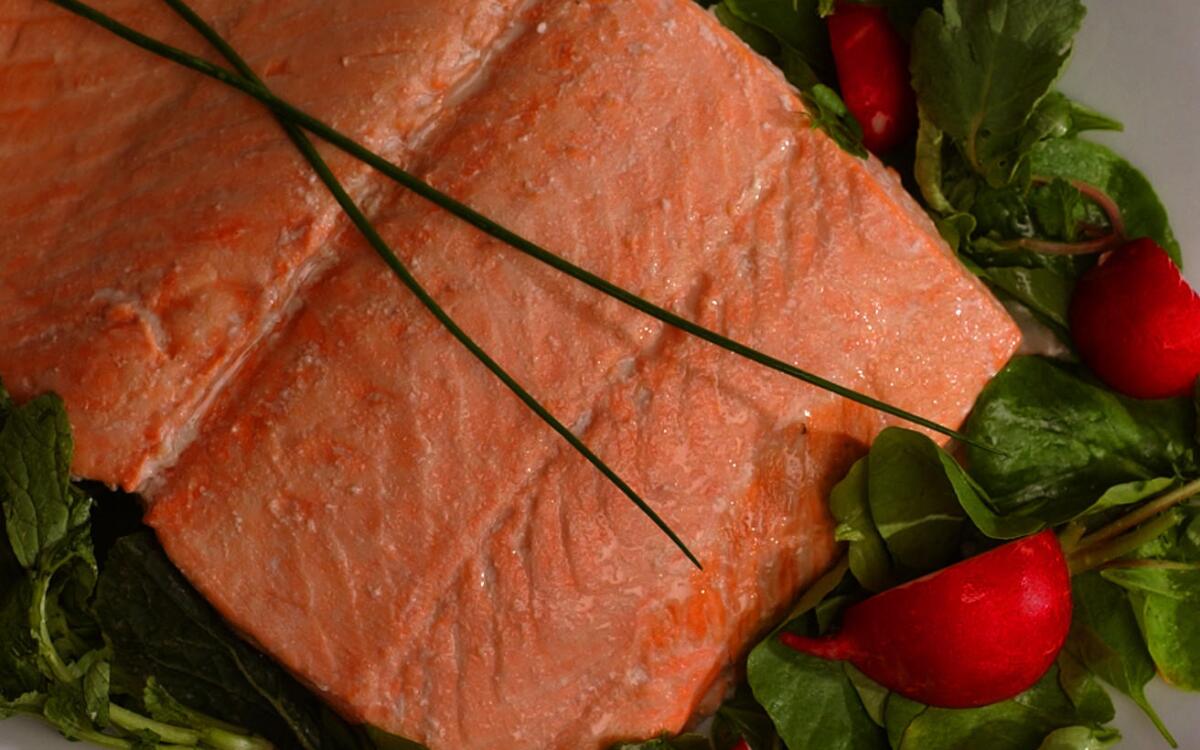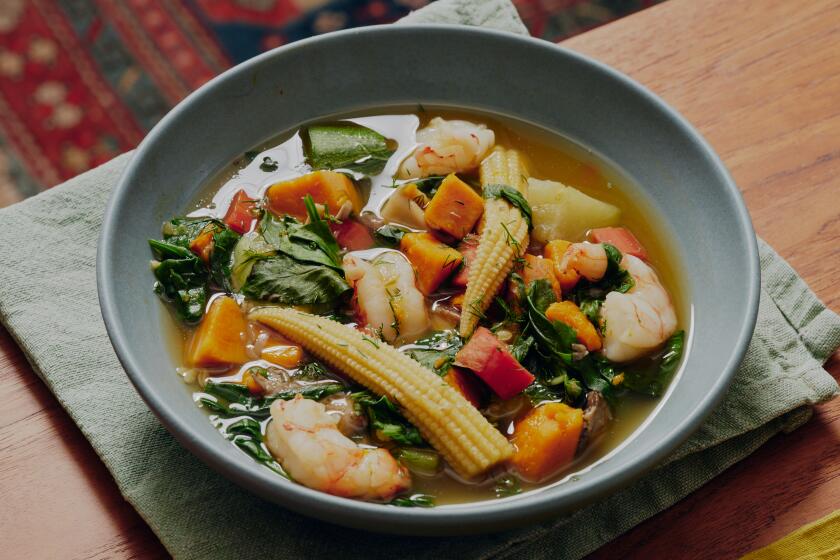Oven-steamed wild salmon with homemade Green Goddess dressing and radish salad

- Share via
So you’ve decided you want to switch to wild salmon. You swagger to the fish counter full of good intentions, ready to seal the deal. And then you take a look. Your jaw drops. Your eyes glaze over.
King, chinook, coho, silver or sockeye? Columbia River, Young’s Bay, Copper River, Kenai, Sitka or Yakutat? Atlantic? And what exactly does troll-caught mean? Is that what those evil little monsters are doing while they’re hanging out under bridges?
You’ll be forgiven if you turn tail and run, especially when you consider the money involved. Driven by demand that is far outstripping the available product, prices for wild salmon generally start at about $15 a pound -- roughly three times that of farmed salmon.
And they go up from there. When the vaunted Copper River kings come in, expect them to start at around $30 -- more than prime porterhouse. Holy cow, indeed.
Buying wild salmon is a puzzle, but it is one worth solving. Though the aquaculture industry has succeeded in turning its farmed cousin into something close to the chicken of the sea in its availability and pricing, wild salmon is truly one of nature’s royals.
The flesh is denser in texture than farmed, and the flavor is much more complex. Though it is leaner than farmed, what fat there is in wild salmon feels different -- it seems to remain in the flesh longer during cooking, and it doesn’t leave that mouth-coating feeling that the fat in farmed can.
But buying wild salmon is more complicated than buying farmed. The first thing you need to know is that salmon is not simply salmon. There are three important species of wild salmon, each with its own qualities (and, even more confusingly, each with multiple names).
At the top of the list is the king, or chinook (Oncorhynchus tshawytscha). This is the largest and fattiest fish, which means that, all things being equal, it will have the most flavor. Next comes the silver, or coho (O. kisutch). It is a little smaller, and the flesh is a little firmer and less fatty. Finally, there is the sockeye, sometimes called “red” (O. nerka). It is the leanest of all, and as its name indicates, its flesh has a red color that is almost shocking in its intensity.
Remember that these are only general categories, though. The next layer of complexity in the salmon puzzle is geographic, and that can have almost as much to do with the quality of the fish as the species.
Salmon are anadromous fish, which means that they are born in freshwater rivers, move to the ocean to mature, then return to the rivers of their birth to spawn. The place names associated with various runs of salmon -- Copper River, Young’s Bay, Kenai -- refer to the river systems in which the fish were born. This is important because each run is slightly different genetically.
Thus, although a Copper River sockeye might be considered inferior to a king from the same place, it might actually be a better fish than a king from somewhere else. Or it might not. Perhaps eventually the salmon runs of the Pacific Northwest will be classified in the same way as the great chateaux of Bordeaux, but as yet there is nothing approaching a consensus.
Be aware that “Atlantic” is not a salmon place name; rather it is a separate species (Salmo salar) and one that vanished as a commercial wild fishery decades ago. The Atlantic name now is an all-but-guaranteed indication of farmed fish.
But don’t confuse farmed fish with the hatchery-raised salmon that have figured in recent news reports. These are fish that are nearly identical genetically to endangered wild salmon, except they are hatched and raised to fingerling size in protected environments before being released into the wild. There they mature and are eventually caught by fishermen alongside wild-spawned fish. Scientists who log the catch for the government agencies that regulate the fishery put them into a separate category, but they are sold as wild salmon. The Bush administration has proposed that scientists count them as wild as well, which could be used to ease restrictions on lumbering and mining along protected streams.
Not only is there no agreement on the ranking of salmon runs, but there also isn’t even agreement as to whether place-named salmon are better than those sold generically as “wild.” These latter fish are generally caught at sea before they have moved to the river mouths to spawn. Sometimes they are labeled “troll-caught” because they are caught by boats trolling in deep water.
These wild salmon, which are caught from Alaska to Northern California, can be every bit as good or even better than the ones labeled with sexy place names. Because the place-named fish are generally caught in water too shallow to be fished by boat, they are caught with gillnets. Trollers argue that their fish are superior because they are caught one at a time by hook and line and thus are treated more carefully.
Can you handle one more layer of complexity? Fresh salmon isn’t necessarily better than frozen. In fact, some of the best wild salmon has been caught, processed and frozen while still at sea. In the trade this is called FAS (frozen at sea).
You will rarely find salmon labeled this way at the market, but if you ask your fishmonger he may be able to point you in the right direction. At the very least, he will be impressed with your savvy and grasp of the jargon and may be more willing to provide help in your selection.
Absent professional assistance, there are several things you can look for when picking out wild salmon. The most obvious is to inspect the flesh carefully. Salmon is actually a fairly delicate fish, and bruising will show up as a kind of mushiness. The muscle should be firm and clean.
Look also at the skin side for any damage in the form of scrapes or missing scales. Choose the largest fish possible; generally it will be the most mature and have the highest fat content. For most purposes, specify that you want a center cut. This will be the most uniform in shape and thickness.
When cooking wild salmon, it’s a good idea to keep in mind how much you paid for it. This is a premium product in terms of quality and cost. You should no more gunk it up with elaborate preparations than you would make hamburger out of a chunk of prime sirloin.
The simplest cooking methods are the best. Two that are particularly good with wild salmon are oven-steaming and crisp-sauteing. They result in fish at opposite ends of the texture spectrum.
In oven-steaming, the flesh stays dense and moist. Cook all the salmon in one piece and then bring it to the table with serving spoons rather than cutting it into portions. The skin should be removed beforehand, as it is so moist that it winds up with a texture like wet tissue paper.
With crisp-sauteing, you go in the opposite direction, squeegeeing all the moisture out of the skin before cooking so that it will crisp into a thin wafer as you saute it. Turn the fish over only at the very end of cooking to keep the center moist.
Whatever technique you use, treat wild salmon with respect. Surround them with accompaniments that know their proper place and will not try to overshadow the star. Simply prepared seasonal vegetables are a good place to start, or maybe something a little crisp, such as a salad or slaw.
If you want a sauce, keep it simple as well -- a drizzle of flavored oil, for example, or a dab of herbal mayonnaise -- and serve it on the side so guests can pass on it if they choose.
Save the fancy dress for common fish; the wild king (or coho or even sockeye) of the sea needs no adornment.
Heat the oven to 300 degrees. Place the salmon, meat side up, on a cutting board and feel along the surface of the flesh with your fingertips just above and below the midline. If you feel pin bones, pluck them out with tweezers or needle-nose pliers. Season the salmon with salt and place in a jellyroll pan.
When the oven is ready, place a baking pan on the floor of the oven and fill it with boiling water. Place the pan with the salmon on the rack. Cook until a paring knife or toothpick penetrates the flesh easily, 25 to 30 minutes. Note that the flesh will be somewhat denser than usual, and it won’t change color as much as with other cooking methods.
While the salmon is cooking, prepare the dressing. Combine the mayonnaise, anchovies, green onion, parsley, tarragon, chives and tarragon vinegar in a food processor or blender or use a mortar and pestle and puree until fairly smooth. There should still be some dots of herbs visible. Set aside.
Wash the radishes well; the greens have a way of hiding grit. Remove any greens that look wilted or yellowish. Pat dry and, leaving the greens attached, slice the radishes into lengthwise quarters. Pick over the watercress, trimming and discarding any tough stems. Combine the radishes and watercress in a mixing bowl.
By now the salmon should be done. There will probably be some white collagen collected on the surface. Moisten a pastry brush with oil and lightly brush it away. Dress the radishes and watercress with the olive oil and red wine vinegar and season to taste with salt.
Serve the salmon on a large platter surrounded by the salad. Serve the dressing in a bowl on the side.
Get our Cooking newsletter.
Your roundup of inspiring recipes and kitchen tricks.
You may occasionally receive promotional content from the Los Angeles Times.
















